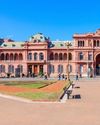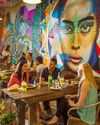New architecture and design help Mexico City attract more business and leisure visitors.

BY 7 A.M. ON WEEKDAY MORNINGS, most of the 22 million residents in the vast and densely packed Mexico City metropolitan area are on the move, commuting to work on crowded buses, Metro trains and suburban rail lines. Every day about 10 million personal vehicles cram the highways and side streets and, if the sky is not too smoggy, wealthy executives fly to work in private helicopters, landing on the rooftop helipads of downtown skyscrapers.
Although known for its cultural institutions and more recently for its modern architecture — named World Design Capital 2018 by the International Council of Societies of Industrial Design — this sprawling metropolis remains a working-class city. An economic giant with a gross domestic product of more than $415 billion, it is one of the largest urban areas in the world based on economic output, accounting for about 22 percent of Mexico’s total national GDP. If Mexico City were a country, it would be the fifth-largest economy in Latin America, five times as large as Costa Rica’s and about the same size as Peru’s.
The oldest capital city in the Americas, built in 1325 by the Aztecs on an island in ancient Lake Texcoco and occupied by Spain in the 1500s, it continues to evolve, even changing its official name last year. Known for two centuries within Mexico as DF (Distrito Federal, or Federal District), now the area of nearly 9 million residents within city limits is officially Ciudad de Mexico, or CDMX for short.
This story is from the March 2017 edition of Global Traveler.
Start your 7-day Magzter GOLD free trial to access thousands of curated premium stories, and 8,500+ magazines and newspapers.
Already a subscriber ? Sign In
This story is from the March 2017 edition of Global Traveler.
Start your 7-day Magzter GOLD free trial to access thousands of curated premium stories, and 8,500+ magazines and newspapers.
Already a subscriber? Sign In

Nurturing Nature
Connect with the abundant flora and fauna of Belize.

Sojourn by the Sea
Discover plenty to smile about in Thailand’s exotic islands.

Colorado Dreaming
For family ski fun, Snowmass and Beaver Creek steal the show.

The Great Outdoors
Anchorage opens the door to all that is wild in Alaska.

Buenos Aires on Foot
Hit the highlights with online itineraries and the city’s free app.

Above and Beyond
Global Traveler celebrates the 2021 winners of the GT Tested Reader Survey awards.

Wellness Wonderland
Reboot at Lake Austin Spa Resort in Texas Hill Country.

Good Vibes
Adelaide’s West End thrives as a hip urban hub close to nature.

Solo Voyages
Cruise lines adapt policies to accommodate those traveling alone.

Grand Slam
Follow the pro tennis tour around the world.